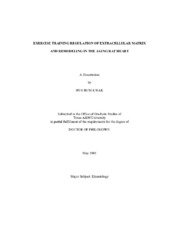| dc.description.abstract | Aging is characterized by a progressive impairment of cardiac structure and
function. The cardiac remodeling involves loss of cardiac myocytes, reactive
hypertrophy of the remaining cells, and increased extracellular matrix (ECM) and
fibrosis in the aging heart. In contrast, exercise training not only improves cardiac
function, but also reduces the risk of heart disease. However, the ability of exercise
training to modulate ECM and remodeling in the aging heart remains unknown.
Therefore, the purpose of this study was to determine the effects of exercise training on
ECM remodeling in the aging heart. We hypothesized that (1) exercise training would
attenuate age-related changes in left ventricle morphology including extramyocyte space
and collagen contents, and (2) exercise training would ameliorate age-induced changes
in ECM-related factors including MMPs, TIMPs, TNF-α, TGF-β1, and α-SMA in the
heart. Three and 31 month old Fischer 344 × Brown Norway F1 hybrid rats were
assigned to four groups: young sedentary (YS), young exercise-trained (YE), old sedentary (OS), and old exercise-trained (OE). Exercise training groups walked briskly
on a treadmill for 45 min/day (12° incline) at 20m/min (young) or 10 m/min (old), 5
d/wk for 12 wk. We found that endurance exercise training might ameliorate the ageinduced
increase in extramyocyte space and collagen contents of the left ventricle.
Exercise training might protect against age-induced fibrosis by increasing MMP-2,
MMP-14 in the soluble fraction and MMP-1, MMP-3, MMP-14 in the insoluble fraction
of old rat hearts. Conversely, exercise training might reduce the fibrosis by decreasing
TIMP-1 in the soluble fraction of old rat hearts. Further, exercise training reduced
potential upstream pro-fibrotic mediators including TNF-α and TGF-β1 in the aging rat
hearts. These results are the first to demonstrate that exercise training has a protective
effect against age-induced extracellular collagen matrix remodeling in the aging heart,
associated with increased MMP-1, -2, -3, -14 and decreased TIMP-1, TNF-α, and TGF-
β1. | en |


